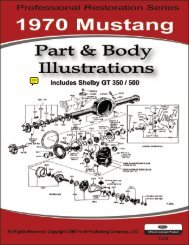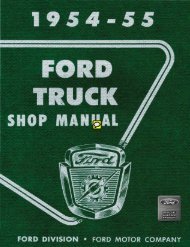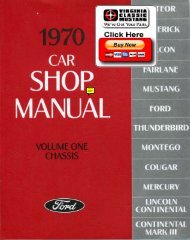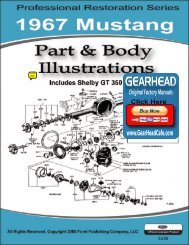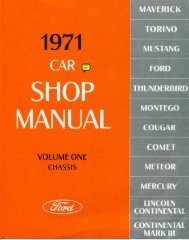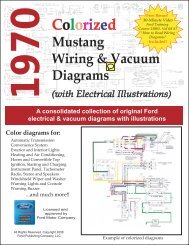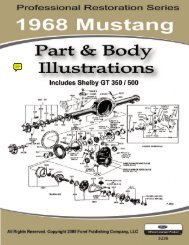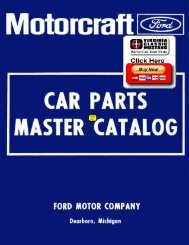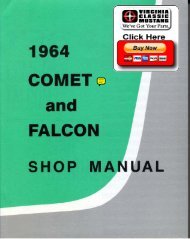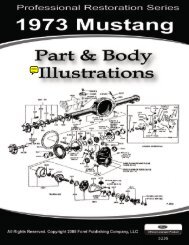DEMO - 1977 Ford Truck Shop Manual - ForelPublishing.com
DEMO - 1977 Ford Truck Shop Manual - ForelPublishing.com
DEMO - 1977 Ford Truck Shop Manual - ForelPublishing.com
Create successful ePaper yourself
Turn your PDF publications into a flip-book with our unique Google optimized e-Paper software.
11-01-7<br />
General Wheel and Tire Service<br />
11-01-7<br />
FRONT WHEEL BEARING<br />
MAINTENANCE<br />
Wheel bearings are adjustable.<br />
Satisfactory operation and long life of<br />
bearings depend on proper adjustment<br />
and correct lubrication. If bearings are<br />
adjusted too tightly, they will overheat<br />
and wear rapidly. An adjustment that is<br />
excessively loose can cause pounding and<br />
contribute to uneven tire wear, steering<br />
difficulties and inefficient brakes. The<br />
bearing adjustment should be checked at<br />
regular inspection intenals.<br />
CLEANING AND INSPECTION<br />
WHEELS<br />
Wheel stud nuts should be inspected<br />
and tightened twice within the first 500<br />
miles of operation. After the first 1000<br />
miles of operation, they should again be<br />
inspected and tightened. Loose wheel<br />
stud nuts may cause shimmy and<br />
vibration. Elongated stud holes in the<br />
wheels may also result from the loose<br />
stud nuts.<br />
Keep the wheels and hubs clean.<br />
Stones or lumps of mud wedged between<br />
the wheel and drum will unbalance a<br />
wheel and tire.<br />
Check for damage that would affect<br />
the runout of the wheels. Wobble or<br />
shimmy caused by a damaged wheel will<br />
eventually damage the wheel bearings<br />
and cause uneven tire wear. Inspect the<br />
wheel rims for dents that could permit air<br />
to leak from the tires.<br />
TIRES<br />
The tires should be checked<br />
frequently to be sure that the air<br />
pressures agree with those specified for<br />
the tires and vehicle model. Inspect the<br />
tire tread, and remove all stones, nails,<br />
glass or other objects that may be wedged<br />
in the tread. Check for holes or cuts that<br />
may permit air leakage from the tire, arid<br />
make the necessary repairs.<br />
Inspect the tire side walls for cuts,<br />
bruises, and other damage. If internal<br />
damage is suspected, demount the tire<br />
from the wheel for further inspection,<br />
repair or replacement.<br />
Check the tire valve for air leaks, and<br />
replace the valve if necessary. Replace<br />
any missing valve caps.<br />
On F-l00, -250, -350, Econoline and<br />
Bronco models, it is important that all<br />
wheels be balanced. Fig. 10 describes<br />
<strong>com</strong>mon tire wear conditions.<br />
FRONT WHEEL BEARINGS<br />
Wheel bearings are adjustable, to<br />
correct for bearing and shoulder wear of<br />
the spindle. Satisfactory operation and<br />
long life of bearings depend on proper<br />
adjustment and correct lubrication. If<br />
bearings are adjusted too tightly, they<br />
will overheat and wear rapidly. An<br />
adjustment that is excessively loose can<br />
cause pounding and contribute to uneven<br />
tire wear, steering difficulties and<br />
inefficient brakes. The bearing<br />
adjustment should be checked at regular<br />
inspection intenals.<br />
Front hub assemblies and bearings<br />
should be cleaned, inspected and<br />
lubricated whenever the hub assemblies<br />
are removed or at the mileage/time<br />
periods indicated in the maintenance<br />
schedule.<br />
New hub assembly grease seals should<br />
be installed when the hub is removed. A<br />
damaged or worn seal may permit<br />
bearing lubricant to reach the brake<br />
linings, resulting in ineffective brake<br />
operation and necessitating premature<br />
replacement of linings.<br />
Bearing adjustment is described in<br />
Part 11-10 for front wheels. Part 11-12<br />
covers front drive bearing adjustment.<br />
Parts 11-11 and 11-14 cover rear wheel<br />
bearing adjustments.




